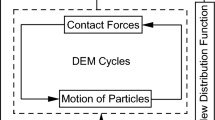Summary
The formation of strain localization influences the stability and stiffness of the soil mass or geosystem. The thickness of shear bands provides insight about overall strength and stiffness inside the granular body, and the shear band angle gives information about the failure surface in a given soil or soil mass. Thus, it is important to be able to predict when a shear band forms and how this zone of intense deformation is located and oriented within the granular medium. A rational finite element analysis for capturing the formation and development of shear bands has been performed and implemented by using a Cosserat continuum in finite element simulations. An extension of plane strain Drucker–Prager elastoplasticity to Cosserat continua is implemented in ABAQUS by using its User-defined ELement (UEL) option. The finite element formulation is discussed in the companion paper. The length scale–size effect relation has been investigated to understand the micro–macro structure relation. Several practical engineering problems are simulated in two dimensions by using the finite element code ABAQUS together with analyst-supplied extensions. The effect of Cosserat parameters on the finite element simulations has been simulated.
Similar content being viewed by others
References
Oda M., Kazama H. and Konishi J. (1998). Effects of induced anisotropy on the development of shear bands in granular materials. Mech. Mat. 28: 103–111
Aifantis E. (1987). The physics of plastic deformation. Int. J. Plast. 3: 211–248
Arslan H. and Baykal G. (2006). Analyzing the crushing of granular materials by sound analysis technique. J. Test. Eval. 34(6): 464–470
Oda M. and Kazama H. (1998). Microstructure of shear bands and its relation to the mechanisms of dilatancy and failure of dense granular soils. Geotechnique 48(4): 465–481
Tordesillas A. and Walsh S.D.C. (2002). Incorporating rolling resistance and contact anisotropy in micromechanical models of granular media. Powder Tech. 124: 106–111
Alshibli K.A., Alsaleh M.I. and Voyiadjis G.Z. (2006). Modeling strain localization in granular materials using micropolar theory: numerical implementation and verification. Int. J. Numer. Anal. Meth. Geomech. 30(15): 1525–1544
Valanis K.C. and Peters J.F. (1996). Ill-posedness of the initial and boundary value problems in non-associative plasticity. Acta Mech. 114: 1–25
ABAQUS Version 6.5 (2004), Manuals, Hibbitt, Karlsson and Sorensen Inc.
Alshibli, K.A.: Localized deformations in granular materials. Ph.D. dissertation, University of Colorado at Boulder, CO (1995)
Alshibli K.A. and Sture S. (1999). Sand shear band thickness measurements by digital imaging techniques. J. Comput. Civil Engng. 13(2): 103–109
Alshibli K.A. and Sture S. (2000). Shear band formation in plane strain experiments of sand. J. Geotech. Geoenviron. Engng. (ASCE) 126(6): 495–503
Yoshida T., Tatsuoka F., Siddiquee M.S.A. and Kamegai Y. (1995). Shear banding in sands observed in plane strain compression. In: Chambon, R. et al. (eds) Localization and Bifurcation Theory for Soils and Rocks, pp 165–179. Balkema, Amsterdam
Alsaleh M.I., Voyiadjis G.Z. and Alshibli K.A. (2006). Modeling strain localization in granular materials using micropolar theory: mathematical formulations. Int. J. Numer. Anal. Meth. Geomech. 30(15): 1501–1524
Alsaleh M.I., Alshibli K.A. and Voyiadjis G.Z. (2006). Influence of micro-material heterogeneity on strain localization in granular materials. ASCE: Int. J. Geomech. 6(4): 248–259
Alshibli K.A., Alsaleh M.I. and Voyiadjis G.Z. (2006). Modeling strain localization in granular materials using micropolar theory: numerica limplementation and verification. Int. J. Numer. Anal. Meth. Geomech. 30(15): 1525–1544
Arslan H., Sture S. and Willam K.J. (2007). Analytical and geometrical representation of localization in granular materials. Acta Mech. 194: 159–173
Arslan, H., Sture, S.: Finite element simulation of localization in granular materials by micropolar continuum approach. Comput. Geotech., DOI: 10.1016/j.compgeo.2007.10.006 (2007)
Arslan, H., Sture, S.: Evaluation of a physical length scale for granular materials. Comput. Mater. Sci., DOI: 10.1016/j.commatsci.2007.08.0 (2007)
Arslan, H., Sture, S.: Finite element analysis of localization and micro–macro structure relation in granular materials. Part I: Formulation. Acta Mech. 197 135–152 (2008)
Author information
Authors and Affiliations
Corresponding author
Rights and permissions
About this article
Cite this article
Arslan, H., Sture, S. Finite element analysis of localization and micro–macro structure relation in granular materials. Part II: Implementation and simulations. Acta Mech 197, 153–171 (2008). https://doi.org/10.1007/s00707-007-0514-0
Received:
Accepted:
Published:
Issue Date:
DOI: https://doi.org/10.1007/s00707-007-0514-0




